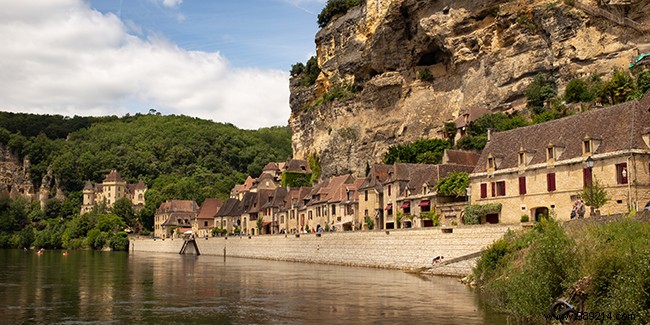
The Périgord noir is a natural region around the Sarladais in the Dordogne. It is so named for the holm oak forests which are very dark. At the same time, this region conceals all very important treasures such as typical villages, prehistoric places of great importance, magnificent castles, a superb natural landscape with a rich history and heritage. The Périgord Noir is still a French gastronomic mecca known throughout the world for truffles, porcini mushrooms, foie gras, ducks, geese, etc. If you are going on a trip there, here are 10 places not to be missed.
Sarlat-la-Canéda is the capital of the Périgord Noir. Discover this magnificent medieval city with many remarkable historical monuments. This city of Art and History conceals a unique heritage in a superbly preserved state. Go to the Place du marché aux Oies and admire the Hôtel de Gisson dating from the 16th century. You can also visit many mansions such as the Maison de La Boétie, the Hôtel Plamon or the Maison du Présiditial among many others. Stop at the washhouse at Roc Bayard for a photo. Also visit the Saint-Sacerdos cathedral, the construction of which began in the 12th century, or the church of the Récollets monastery, which has become the chapel of the White Penitents. Sarlat is a real open-air museum where you can spend several days if you want to discover everything.
The prehistoric paintings found in the Grottes de Lascaux are around 17,000 years old. The cave was discovered in 1940, but was closed to the public so as not to damage the paintings which were damaged. It was in the early 1970s that a first copy was built to be opened to the public in 1983. Then other constructions identical to the original cave opened their doors. You can see the exact copy of the Hall of the Bulls, the Axial Diverticulum, the Diverticulum of the Felines, the Nave, the Apse, the Passage and the Wells. All the drawings dating from prehistoric art are extraordinary.
The castle of Beynac, dominates the village and the Dordogne. This medieval fortress began to be built in the 12th century. It is in an exceptional state of preservation. By visiting it, you will walk in the footsteps of Richard the Lionheart or Simon de Montfort. Its keep is 150 m high and you can have access to a magnificent view.
Stop at Castelnaud to visit the Château des Milandes which belonged to Joséphine Baker who transformed it into a home for the children she had adopted. In a tower, you can see the instruments of the falconer. You can also visit the falconry and the very pretty gardens of the park.
On the road to the 1001 Périgord castles, you can stop at the Manoir d'Eyrignac to visit its exceptional gardens organized in the French style and dating from the 18th century. Still belonging to the same family, these gardens have been brought up to date by the current owner who has given them back their letters of nobility.
Cadouin Abbey is located in the village of the same name. It was founded in 1115 to accommodate the order of Cîteaux. This abbey restored during the revolution and its cloister form an exceptional architectural ensemble. Do not miss the visit of this unique and so magnificent place.
The Périgord Noir is also the land of Man and that of Prehistory. On your way to visit the Vézère valley, stop at La Madeleine to visit an exceptional natural site. At the foot of the cliff, here are about 17,000, hunter-gatherers took up residence there. An incredible prehistoric deposit was found there and the site gave its name to the prehistoric civilization called the Magdalenian. You will be able to see a mammoth engraved in mammoth ivory, the burial of a child adorned with 1150 shells and the famous “Bison licking its side” painted by the Cro-Magnons. In the center of the cliff, you will see the troglodyte village which was inhabited from the Middle Ages until the end of the 1890s. A Gothic chapel from the 15th century is built there as well as the ruins of the castle of Petit-Marzac.
Les Eyzies-de-Tayac is known for being the country of man, which is materialized by the statue of the Neanderthal man by Paul Dardé dominating the village. Les Eyzies is also the Grand Roc cave known for its eccentric crystallizations and especially for its numerous prehistoric sites. You can admire prehistoric polychrome paintings in the Font-de-Gaume cave or go see:
All these prehistoric sites are classified as World Heritage by Unesco and have made it possible to better know our ancestors.
La Roque-Gageac (photo) is still a beautiful village in the Périgord Noir located just next to Beynac. You can visit it by walking through its medieval streets and see its 12th century fortress. This fort, totally built on a rock, was almost impregnable by the enemy, because it was impossible to climb or undermine. You can see many defensive elements such as defensive wells, arrow slits, walkways, loopholes, airlocks, etc. During the Hundred Years War, it was never taken and withstood many assaults.
Still in the pretty Vézère valley, in Audrix, you can visit the Gouffre de Proumeyssac which is a cavity of more than 50 m. You can admire many crystallizations along the walls highlighted by a play of lights. You can also take the forest route to discover the local flora, picnic in the shaded park, and visit the geological space explaining the local phenomena in this area.
These ten visits are all superb to make, but the Périgord Noir is still home to a large number of them. If you have time to disperse during your stay, go on a little adventure to discover magnificent places and do not forget to take a barge ride on the Espérance River.